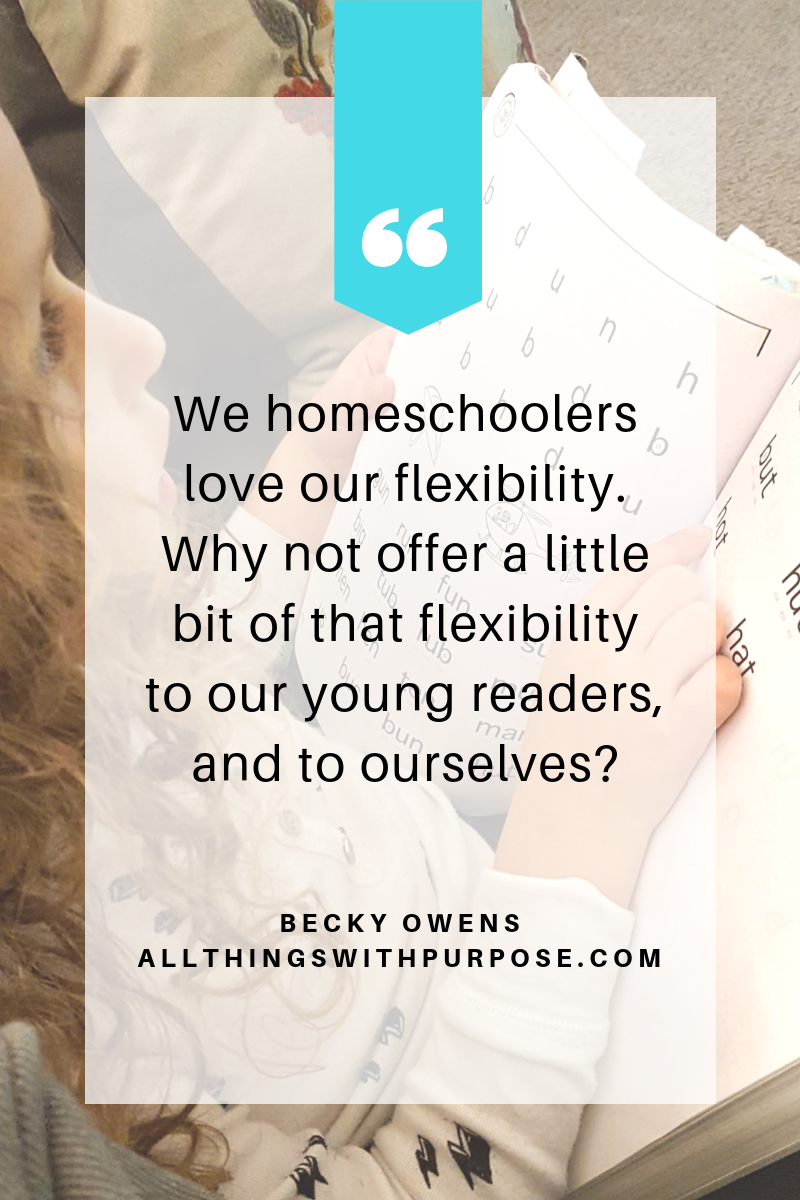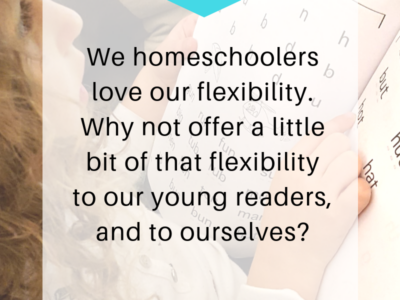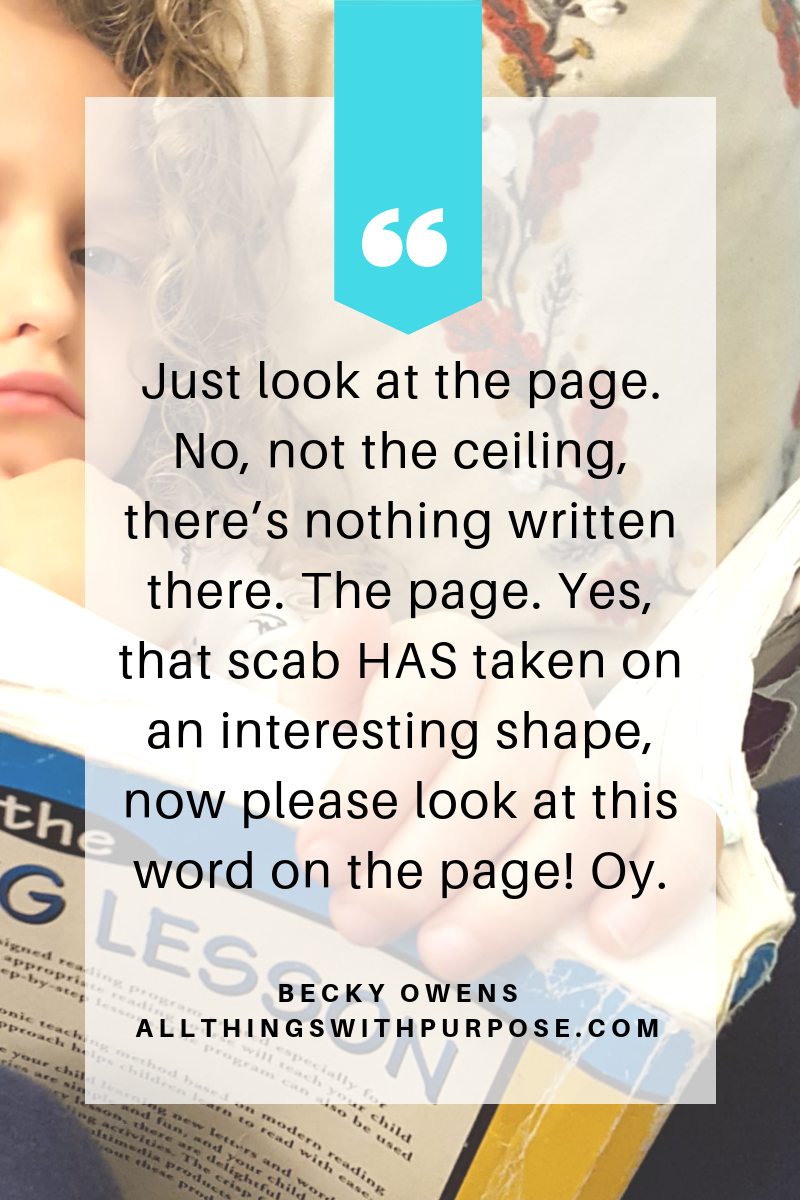
I’m excited to introduce you to my sister, Becky! Becky is joining my contributor team and has a lot of great ideas and insight to share. She will be writing about homeschooling, money saving advice and anything else she might think up. To see all of Becky’s posts, go here: Becky Owens
To follow her on Instagram, go here: @Rebecko on Instagram
Teaching Your Child to Read
Teaching my kids to read has been one of the most rewarding aspects of homeschooling, and motherhood in general, for me so far. It has also been one of the most frustrating. I mean the kind of frustration that causes you to want to throw the book against the wall and resign to the fact that your child will just have to go through life relying on Audible for all of their literary needs.
I think with my first two kids we just muddled through it. We did the lessons every day and they did fine. They wanted to learn. It took work, but the reward came at a reasonably quick pace and before I knew it they were choosing stacks of books from the library and sneaking books into their beds at night.
My third kid is another story. She’s a free spirit with a heart of gold and an inability to grasp that one must look at the page of the book in order to read the words written there. Seriously. This has been half my battle with her.
“Just look at the page. No, not the ceiling, there’s nothing written there. The page. Yes, that scab HAS taken on an interesting shape, now please look at this word on the page! Oy.
Mom Guilt
I used to dread sitting down with her, knowing that if I went into it with the wrong attitude, I would end up turning it into a time that she would dread too. I didn’t want to suffocate her love for reading before it even had a chance to sprout. So, we spent less and less time working on reading. Instead, we did her fun Preschool and then Kindergarten work books. I read aloud to her. We visited sites like Teach Your Monster to Read and Starfall on the computer. And we had lots and lots of free play time.
The mom guilt should have been piling up at this point. I was almost waiting for it to poke in with its ugly chartreuse head (My mom guilt is chartreuse. What color is your mom guilt?).
But the thing was, I wasn’t worried about it. Even though I’m sure others might have thought I should be. Even though I knew of plenty of kids who were already reading chapter books at her age. She was in Kindergarten. It was OK that she wasn’t reading. We could have puttered along at an annoyingly slow pace, dedicating 15 minutes a day to the sounding out of a single word. I could have kept wrangling the bored, easily distracted five-year-old, forcing her to sit with me, completely oblivious to the fact that I was frustrated to the point of tears. But why? She’ll learn it in First grade. I’m allowed to wait until First grade.
By the way, when did we reach the point that reading at one’s grade level is not viewed as a major accomplishment?!
Tangent to Follow
Is it just me, or does it seem like the only people who have bragging rights are the 1st graders reading at a 6th grade level? I mean, don’t get me wrong, I’m super proud of those kids. I know those kids and I love them. They’re amazing. But I’m also super proud of my 4th grader whose reading at a 4th grade level.
In Sixth grade, I was reading The Babysitters Club books, because that’s how old the kids in the books were. But I wouldn’t want my 4th grader reading those books yet because she wouldn’t relate to the characters in the same way she would if she waited a couple years. But these are the sort of books written for the 6th grade reading level, so what is the advanced 4th grader to read?! Ok. I’m not really sure this fits in with any of the points I’m trying to make. I really just wanted a reason to talk about The Babysitters Club.
I know.
I’m such a Mary Anne.
But the point is, we need to give these “average” or even “below average” kids a little credit. Have we forgotten how hard it was to learn to read? On a recent trip to the library I introduced my kids to the area that houses the Braille books. As we closed our eyes and ran our hands over the raised Braille letters, I was struck with how overwhelming it would be to have to learn to read these books with any level of speed and comprehension. It’s like learning a foreign language! That really helped me to develop some much-needed empathy for my pre-readers. If I put myself in their place, staring at the pages of these books filled with letters and symbols they have yet to learn or retain the meaning of, their ability to learn this stuff at any age is nothing short of amazing! Kudos to the kid who learns at 3 years old! But equal kudos to the kid who is just catching on at 6 or 7, who struggles with reading comprehension at 8 or 9, and who is finally reading for learning by 11 or 12.
End tangent.

My First Grader
So, anyways. Kid number three. She’s in First grade now and she is just getting to the point where I can see the concepts sticking. But guys, she’s getting it. I tried doing these same lessons with her last year and it was beyond frustrating. Today, we reached the 5th chapter of The Reading Lesson, a book that I love and also used to teach my (now) 11 and 9 year old. She enthusiastically read the story and then sat for another ten minutes looking at the lessons ahead and getting excited about the stories she would be able to read in the near future! What a huge change in this girl!
The only thing that has changed from before is the simple fact that she’s a whole year older than she was last year. Groundbreaking. I know. But sometimes life isn’t as complicated as we try to make it.
She’s in First grade. This is the year she’ll learn to read. She is ready. I can feel it. I can see it. She can too. The enthusiasm is contagious. And if she wasn’t ready for it this year either? I would probably wait until Second grade. And I hope that I would still be waiting for the mom guilt to make an appearance then.
This has been my experience. I know there are a lot of other factors out there that may contribute to a kid not wanting to read, or not being able to read. Sometimes a curriculum change is in order. Sometimes some testing, to see if they need any specialized help. I also understand that slowing down and allowing a student to go at their own pace may not be an option given to children enrolled in public or private schools. But for the majority of homeschooling families, this is an option. We homeschoolers love our flexibility. Why not offer a little bit of that flexibility to our young readers, and to ourselves?



Leave a Reply